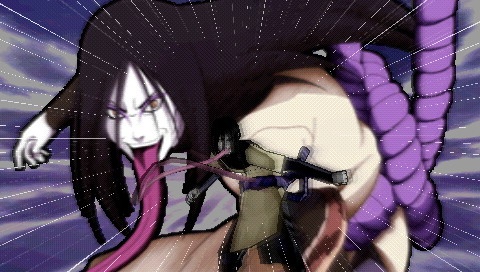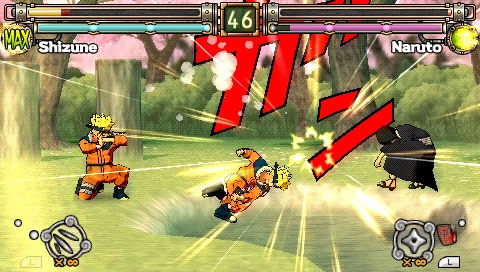Naruto: Ultimate Ninja Heroes 2: The Phantom Fortress is a mostly recycled fighting game placed within a hollow adventure. To lay its basic contents bare, this game contains a lengthy single-player campaign called The Mugenjo, a series of team battles called Heroes mode, a head-to-head battle, a bonus content area called Ninja Road, and finally, Naruto's House, where you can view purchased bonus items. It's a ton of content, and it would take you well over 10 hours to explore all of it. It will take you only about two hours, though, to get tired of it.
The single-player campaign, The Mugenjo, takes place in the Phantom Fortress. This floating palace of doom is 99 stories tall, and each story contains several rooms and stairs. For instance, when you take the stairs up from the third floor, you'll find that there are two or three rooms between you and the stairs up to the fifth floor. In all likelihood, the two or three rooms in front of you will be blank. This means you need to "summon" a room through which to travel. To do this, you need to use a room-summoning scroll. At any given time, you have four of these, and when you use one, it's replaced by another at random.

Here are the types of rooms you will be able to summon: battle (a single match against a CPU opponent), pop quiz (a three-question quiz on Naruto lore), clone room (three-card monte), shadow possession (button-press mimicking), tree climbing (branch-dodging test of speed), and amusement room (slot machines). It's not exactly what you would hope for in a floating palace of wonder and excitement. Here's the worst part: The castle has 99 floors, and you generally have to play through two or three summoned rooms on each one. Even worse, winning or losing in a summoned room has no bearing on the plot. The only thing your performance in a summoned room affects is the number of ninja points you get, and these are used to buy screenshots, audio tracks and the like from the bonus area. This makes the mini-games seem frustratingly pointless.
The only rooms you need to make sure you complete successfully are battle rooms. You aren't playing as just one person; you're a whole four-person team of ninjas. So if you lose a match, the next ninja steps in and resumes the fight. If you intentionally lose four fights in a row, the game asks you if you want to choose a new difficulty and then restarts you at the beginning of the match you just lost, with all of your ninjas completely recovered.
There are three types of rooms in the floating castle that you don't summon. These are healing rooms, treasure rooms, and drama rooms. Healing rooms heal all your ninjas and refresh your ninja skills; treasure rooms contain items you can use in battle; and drama rooms are where the plot happens. Most treasure rooms are behind some kind of barrier, like a pile of rocks, and you can use a special technique to clear the way and get your treasure. But wait! You have a limited number of these techniques (until you find a healing room and refresh them), and they can also be used to open up shortcuts. This creates a dilemma: Do you want to go straight to the next floor or play a game of three-card monte and take a pop quiz to get your hands on two healing medicines in the treasure room? Unless you're a huge three-card monte fan, the choice should be pretty simple.

The only remotely interesting rooms are the drama rooms. You'll find one of these every several floors, and each relays a small tidbit of the overarching plot. There is one big problem here: It's a 15-minute story stretched over a six-hour trek up 99 floors of pop quizzes and repetitive fights. You'll get to the point where you don't care what the deal is with the Princess of Dusk if it means fighting Gaara again or, even worse, taking another quiz.
The Mugenjo fails as a single-player campaign in that it's simply not worth finishing. That leaves Heroes mode, where you pick a team of ninjas and fight against other teams. But by the time you've given up on The Mugenjo, you will probably be too tired of the game's ultrasimple combat to care. This is the same fighting system found in Naruto: Ultimate Ninja 3, which pretty much makes it the same one found in the other three Ultimate Ninja games as well. This fighting system is barely deep enough to last one game, much less an entire series.
There is one attack button, and it does different things depending on the direction you press on the D pad. You can also teleport toward your opponent by pressing jump twice. You can activate a special attack by hitting a button and then successfully executing a normal attack. This leads to a brief cinematic that shows you executing the special attack, which then hits for considerable damage. Fights go like this: You teleport up, beat the crap out of your opponent until your special attack meter is full, and then try to execute a special attack. If your opponent blocks it or smacks you, you repeat the process. If you successfully land the special attack and your opponent doesn't die, you also repeat the process. It's very boring. On the bright side, it's also very accessible. If you wirelessly play matches against friends who don't own the game, they'll pick up the controls in no time.
The rest of the game is much less cool. For instance, Ninja Road. This feature lets you spend points on bonus content. Every 100 points buys you one bonus. For some reason, the whole thing is displayed as a 2D Naruto walking down a road, picking up bonuses every 10 meters. Ten meters, by the way, translates into 100 ninja points.
Phantom Fortress looks good, especially during combat. The animation is fluid and the frame rate is stable. The story parts also look pretty good, except that they aren't fully animated. Fortunately, no corners were cut with the sound production. The music is straight from the show and and there is a ton of authentic voice-over work in both English and Japanese.
Naruto: Ultimate Ninja Heroes 2: The Phantom Fortress is a boring game. Even if it didn't try to convince you to take so many quizzes, the weak plot and completely recycled combat would fail to inspire an "Ooh," much less an "Aah." Rather, the bevy of bad minigames and the uninspired bonus acquisition system are sure to elicit some yawns. After only a few hours, you will probably be ready for this Phantom Fortress to disappear.
